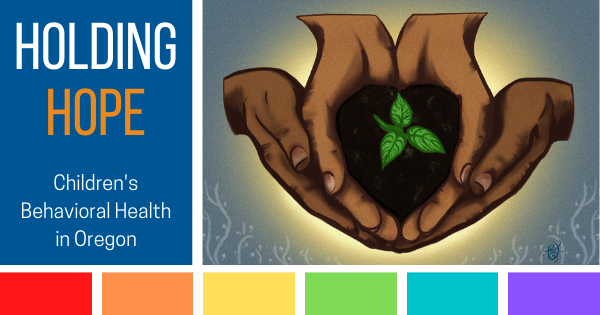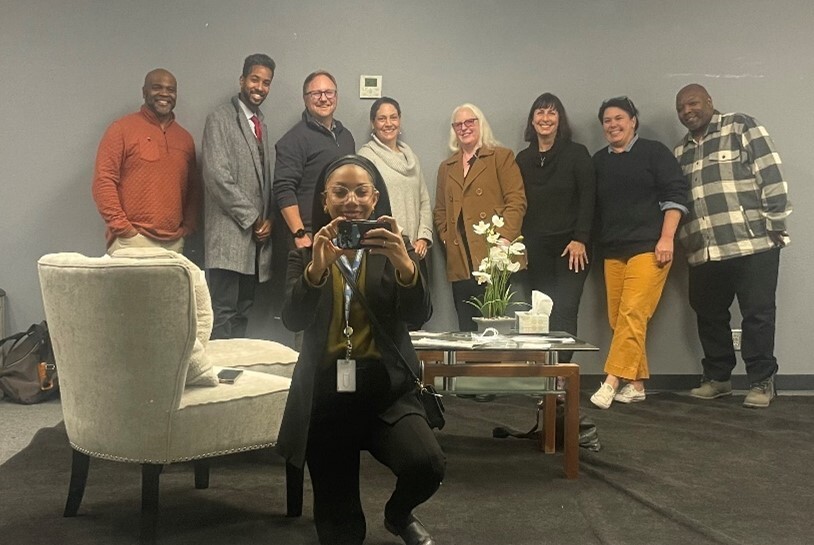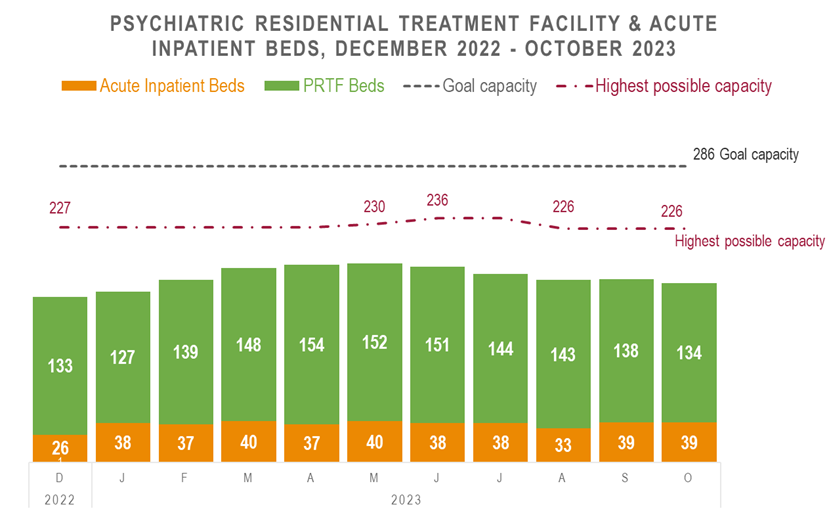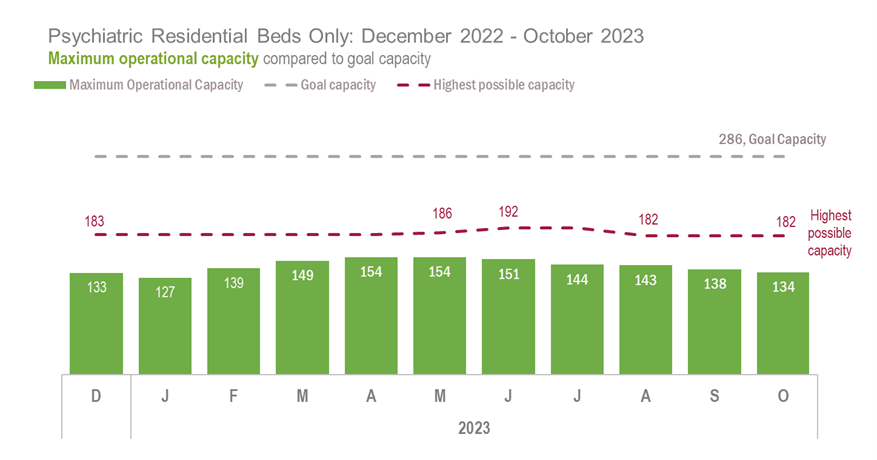|
Having trouble viewing this email? View it as a Web page.
Lea en español
 Dec. 1, 2023
In this issue...
Reflections from Oregon Health Authority's Child and Family Behavioral Health (CFBH) Director, Chelsea Holcomb

Across many cultures, winter represents a time of renewal and togetherness. December holds the winter solstice, the shortest day of the year, and surrounding the solstice lies a host of traditions, feasts, and time with family and friends. These shorter and colder days bring us together to celebrate, build our community, and look forward to the longer days of sunlight ahead.
It can also be a lonely time of year for many of us, where we can feel a lack of connection as we hunker down during the winter storms and may be far away from our chosen or biological family. Humans by nature are social animals, and through our learning about isolation from the pandemic, this time of year can offer an opportunity to reflect on how we can protect ourselves from loneliness throughout the year.
In the digital age, technology provides us with numerous ways to stay connected. Video calls, messaging apps, and social media platforms offer real-time communication, allowing us to bridge the gap between physical distances. Schedule regular virtual hangouts with friends and family to share updates, laughter, and the warmth of your presence, even if it's through a screen. Winter provides an excellent opportunity to explore indoor hobbies that can be shared with others.
Whether it's cooking, crafting, or learning a new skill, involving friends or family in these activities fosters connection and creates shared interests. Staying connected during the winter requires intentional effort, but the rewards are well worth it. Plan activities, send thoughtful gifts or handwritten letters, and participate in community events to create a sense of warmth and togetherness. By proactively nurturing your relationships, you can make the winter season a time of connection, joy, and shared experiences. If you need to connect with a peer who understands what you’re going through, you can reach out to organizations such as Oregon Family Support Network. Their team is made up of people with lived experience, who can connect with you and support you through whatever you need.
I was lucky to do a site visit with REAP in Portland, along with CFBH manager Jessie Eagan. REAP is a year-round multicultural youth leadership program committed to empowering the next wave of leaders. REAP works with students grades 3 through 12, who represent our most marginalized student populations. The work this group does to lift up kids throughout Oregon and to connect them is very important. None of us have to walk alone, and our lives become all the richer by the hands we extend and the hands we embrace.
|
 |
From left to right: Mark Jackson (REAP Founder/Executive Director), Anderson DuBoise (REAP Strategic Initiatives Manager), Adam Peterson (Health Share of Oregon Behavioral Health Program Manager), Nikobi Petronelli (kneeling in foreground) (OHA Office of Recovery and Resilience), Anna Williams (Director of System of Care Advisory Council), Amy Shea Reyes (CareOregon Behavioral Health Program Manager), Chelsea Holcomb, Jessie Eagan (OHA CFBH Manager), Levell Thomas (REAP Founder/CEO)
Since 2013, School-Based Mental Health (SBMH) programs have been a critical legislative investment in supporting youth mental health. Students and families have access to clinical and crisis services in a familiar setting with many common barriers removed, such as transportation and requirements. Principal Jerimy Kelley of Scappoose High School shares the following example and highlights their successful partnership with Columbia County Mental Health.
“In the fall of 2021, we arrived for all-school in-person learning for the first time in multiple years; we faced many new and unknown challenges that could cause barriers to student success. One of the most significant hurdles we faced was the exponentially growing mental health support needed by students within our school.
“As the Vice President of Columbia Community Mental Health (CCMH) and school principal, I feel blessed to work with individuals like school counselors Aarin Pinkstaff and Alyssa Bettendorf, CCMH therapist Dan Jewell, and care coordinator Justin Engstrom. Our team came together and evaluated data showing us a growing need for an innovative and responsive plan to support our students inside the walls of our school.
Scappoose High School, The Wellness Center
“One prominent outcome of the meeting was the idea of a wellness center, a confidential space within the school where students can have time to regulate and seek support from a team of helping professionals. We hoped that having a positive and supportive environment that students could access would have a positive impact on their mental health, help them remain in school, continue learning and succeed academically. We collaborated with student services director Whitney Hessong and superintendent Dr. Tim Porter to braid funds from CCMH, the Student Investment Account, and our General Fund to support our project.
"The Wellness Center has already been a tremendous asset for our students, 48 students have already accessed supports at SHS within the first 35 days of this school year. Our team also worked with CCMH’s Board to fund a youth and family system navigator, Rob McQueen-Jensen, to support students and families in accessing mental health services. As we know, when students’ basic needs are met, students can access school and learn and grow as individuals. This center has directly impacted our increasing graduation rate and On-Track data at SHS by positively impacting students’ mental health. We look forward to sustaining this school-based program through the collaboration and support of CCMH and our partners at the state.”
From left to right: Scappoose High School Principal Jerimy Kelley, CCMH Therapist Dan Jewell, District Care Coordinator Justin Engstrom
Oregon Health Authority (OHA) recognizes the value of peer-delivered services (PDS) and the role they play in transforming a behavioral health system of care. With this value in mind, OHA established the Office of Recovery and Resilience (ORR) in 2021, led by nine certified Peer-Delivered Services (PDS) workers. The ORR ensures that individuals with lived experiences have a voice in decision-making and fosters the growth and strength of the PDS system in Oregon. The state has various PDS worker types, and the ORR played a key role in defining "Peer Run Organizations" (PROs) through House Bill 2980 (2021).
Through substantial financial support, education, and technical assistance, the ORR has facilitated the expansion of PROs and PDS workers across Oregon. This expansion includes a $6 million allocation for four Peer Respite Houses and a $5 million grant distribution to enhance PDS workforce capacity, emphasizing cultural specificity and addressing historical underfunding.
Guided by community, the ORR has begun large-scale learning collaboratives, community engagement, administrative rule and policy for Peer Respite Houses to open this next fiscal year.
PROs and PDS workers are widely available across Oregon. PROs function as community-based activity centers offering PDS to any Oregonian in need of mental health or recovery support. The ORR's community engagement efforts have integrated PDS into health care at all levels, forming partnerships between health care sectors and the PRO system.
The ORR advocates for the inclusion of lived experiences in policy and systems at OHA, responding to large-scale advocacy for PDS with legislative implementation and policy development. Last month, Beau Rappaport was announced as the interim director for the ORR. He said, “The ORR has served as behavioral health community engagement experts in spaces where different departments of the agency come together to create a collaborative workforce, break silos, and work more effectively to strategize and implement programs, projects, and community involvement across divisions and systems. The ORR has also spoken to peers as they complete their certification process, letting them know how valuable they are to the behavioral health and the substance use disorder workforce — breaking stigma and inspiring new peers.”
The ORR has garnered recognition for fostering trust and care in historically underserved communities, aligning with OHA's health equity statement. Projects across Oregon include internal support, community partnerships, and reducing barriers to becoming a certified PDS worker. OHA's efforts have led to over 4,500 certified PDS workers contributing across the entire continuum of care in the state.
The 2023 Oregon Suicide Prevention Conference was held in Hood River from November 6-8. This conference allowed partners gathered from across the state to learn and to connect. The work of suicide prevention can be really exhausting which makes gathering of utmost importance.
This year’s theme was “Hope Across the Lifespan: Care in Action.” On the plenary stage, we heard messages from Dr. Ruth Zuniga, Dr. Ursula Whiteside, Simone Nagle, and Kera Magarill as well as from panels on the Black Youth Suicide Prevention Coalition and local work happening in Hood River. Recordings of the plenary stage will be available soon on the OSPC 2023 website.
OHA Suicide Prevention team from left to right: Shanda Hochstetler (CFBH), Deb Darmata (Adult Behavioral Health), Taylor Chambers and Meghan Crane (Public Health Division, Injury and Violence Protection), Jill Baker (CFBH)
The National Association of State Mental Health Program Directors (NASMHPD) announced that OHA was awarded two Transformation Transfer Initiatives (TTI) grants of $250,000 each for culturally specific suicide prevention. This year’s TTI umbrella topics hold relevance and value for all states and territories: 988 expansion and improvement and expansion of crisis services — including suicide prevention. Its five unique subtopics encourage creativity, flexibility, collaboration, and coalition-building opportunities. In addition to the funds, the TTI awards offer technical assistance, learning opportunities, networking, and enveloping support from NASMHPD staff to help guide teams to achieve their intended outcomes.
For Federal Fiscal Year 2023, SAMHSA awarded 50 TTI awards of $250,000 to states and territories on topics directly related to implementing and expanding 988 and crisis services. OHA received two awards.
- One award will be focused on providing youth suicide prevention in Black, African American, and African communities by supporting the Black Youth Suicide Prevention Coalition and the Life-Sustaining Practices Fellowship program.
- The second award will be focused on making suicide prevention trainings available and accessible to Spanish-speaking and Latine communities.
If you are interested in speaking into or being involved with the work of either of these two grants, please reach out to Shanda Hochstetler at shanda.hochstetler@oha.oregon.gov or Jill Baker jill.baker@oha.oregon.gov.
We are excited to announce that the application window for the Life-Sustaining Practices Fellowship for Black, African, or African American youth-serving adults is open through Dec. 10, 2023. This is a program funded by Youth Suicide Prevention at OHA, and is led by well-known and respected Black, African, and African American researchers and practitioners.
This fellowship opportunity is in partnership with Portland State University and led by Dr. Tiffani Marie, Dr. Kenjus Watson and Dr. Shante Stuart-McQueen.
The purpose of this program is to gather and equip Black, African or African American youth-serving adults in life-sustaining practices rooted in ancestral ways of knowing and being and healing — with the intention of using those learnings with youth they serve as protective factors against suicide. Culture is suicide prevention. Fellows will be given the opportunity to participate in associated research about the impact that healing connected to culture, connection and consciousness provides. Learn more about that work here.
Fellows will receive a monthly $300 stipend to attend monthly two-hour gatherings in person in the Portland metro area from February 2024 through August 2024.
If you are a Black, African, or African American youth-serving adult, please consider applying for this opportunity! If you know someone in this community that is doing excellent work with youth, please consider encouraging them to apply. If you have questions or concerns, you can reach out to Dr. Kenjus Watson at kenjus.watson@gmail.com or by phone (951-660-6879).
Governor Tina Kotek has chosen Dr. Sejal Hathi to be the next OHA Director, pending approval from the Oregon State Senate. Dr. Hathi will start her new role January 16. The Governor took into account input from the community and staff when making this decision. Dr. Hathi went through various interviews, including with Tribal leadership, Racial Justice Council members, Oregon Health Policy Board members, OHA staff, leadership, agency directors, the Governor’s Office, and the Governor herself.
Before this appointment, Dr. Hathi was the deputy health commissioner for public health services in New Jersey. She has also worked as the Senior Policy Advisor for Public Health at the White House, where she led important public health initiatives for the Domestic Policy Council. Dr. Hathi is a certified physician and has teaching experience at Johns Hopkins School of Medicine and the Bloomberg School of Public Health. She cared for COVID-19 patients at Massachusetts General Hospital and Harvard Medical School.
Dr. Hathi has been involved in public service and health-related national boards. She co-founded two social enterprises supporting women's and girls' leadership globally. In 2013, she was appointed as one of nine public health leaders advising the UN Secretary-General on women's and children's health. Dr. Hathi earned a B.S. with honors from Yale University and holds an M.D./M.B.A. from Stanford University.
The Governor and her team appreciate Interim Director Dave Baden's efforts during the search. Baden will continue working at OHA as a deputy director overseeing major programs and policies. Kris Kautz will remain as a deputy director overseeing agency operations.
Intensive Treatment Services (ITS) capacity remains a critical concern to CFBH. Each week we receive data on capacity for acute psychiatric inpatient beds, psychiatric residential treatment facility (PRTF) beds, and substance use disorder (SUD) residential beds. ITS programs include psychiatric day treatment programs, residential treatment programs, secure inpatient programs and acute psychiatric inpatient units.
Change to ITS capacity reports
Below there are two graphs which may look different from capacity data shared in previous newsletters. The first one is a bar graph represented in two colors. Orange represents acute psychiatric inpatient beds and green represents PRTF beds. In previous months we did not distinguish between these two bed types, as they are both considered psychiatric beds. However, moving forward we will separate the two types to better specify our goal of increasing PRTF capacity.
 The second graph shows only PRTF bed information, but has the same goal of 286. When the goal was set it was meant to specifically be a PRTF capacity goal. We will eventually phase out reporting on the acute inpatient beds and solely report on PRTF capacity in the newsletter.
 Referral and Capacity Management (RCM)
In late September OHA shared with PRTF programs a new innovative system for referral management called Referral and Capacity Management (RCM). RCM is a secure web-based platform designed as a tool for providers to manage program referrals and waitlists, and to give them a high-level view of their census and upcoming openings.
Our current capacity tracking produces a weekly snapshot of these providers’ census and capacity information. RCM will be able to provide daily updates. RCM is being launched as a pilot with four PRTF programs; the goal is expansion to all ITS programs in the future.
This past month, we have been working with our PRTF partners to familiarize them with RCM and gather their feedback. The next step is to work with our IT team at OHA to make revisions and additions to the system based on the insights we have gained from PRTF providers. The goal is to have the participating providers trained on RCM and begin using it within the first quarter of 2024.
Find events, opportunities, trainings and resources in last month’s posting. Many of these trainings are also on our website. We will send updates mid-month — Look for the next one in your inbox on December 15.
For feedback and suggestions for our newsletter and information: kids.team@oha.oregon.gov.
Subscribe to OHA Behavioral Health Updates
Did someone forward or share this with you? You can subscribe here to get future issues of Holding Hope and other updates for Oregon behavioral health providers and partners.
|